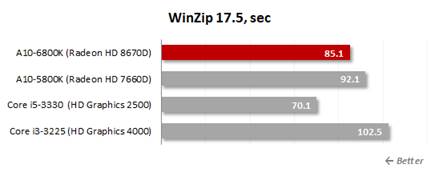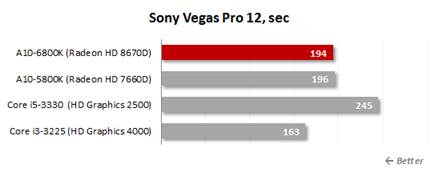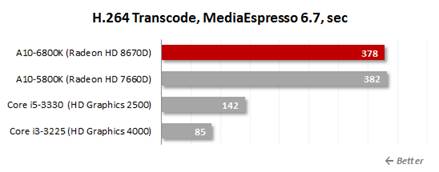Heterogeneous computing performance
Promote its mixture processors AMD continues
to remind us that the integrated graphics core can be used to speed up
calculations based on common purpose. That is true. OpenCL and DirectCompute
framework allow parallel calculations on both x86 and graphics cores that are
supported by both AMD Trinity and Intel Ivy Bridge versions. And while they
have been used by very few specialized applications, the concept of
heterogeneous computing has become more popular now. Today AMD has a pretty
impressive list of applications that are accelerated in the APU due to graphics
core potential.

The
list of applications
That's why we want to run some tests in the
applications that can use all full of versatile resources provided by the
mixture processor.
We want to start with a special benchmark
Basemark CL, copy the typical command, which uses OpenCL computations, such as
image processing or physics simulation with intuitive results. Moreover,
Basemark CL also takes into account the arithmetic possibility of OpenCL
computer units.

Basemark
CL
The advantage of the AMD, APU is clear and
irrefutable. At the same time Basemark CL shows a significant increase in the
performance of Richland compared with Trinity. It seems to be optimized drivers
that create the fool here.
The second OpenCL Benchmark, we use SVPMark 3.
It is a specialized performance benchmark for Project SmoothVideo software
improved video playback smoothness by inserting a new intermediate frames in
the video stream. This software uses positive GPU resources via OpenCL.

SVPMark
3
Here, AMD A10-6800K is again significantly
faster than Intel processors. However, the performance difference between them
and their predecessors with Trinity design is really negligible and only 3%.
One of the greatest achievements in this APU
model is the widespread adoption of it by the software market that is the introduction
of the OpenCL in the popular store WinZIP utility. We use WinZip 17.5 to
compare the compression speed of 850 MB folder with the files into Zipx format.

WinZip
17.5
Calculation acceleration in OpenCL helps AMD
processor to do better than Core i3-3225. However, both Richland and Trinity
products do not beat the quad core Core i5-3330. Note that the performance
difference between the A10-6800K and A10-5800K is about 8% in this case.
Another example of a common OpenCL compatible
application is the Sony Vegas Pro 12 professional video editing tools. When
rendering video, it can distribute the load to all the computing resources of
the mixture processor.

Sony
Vegas Pro 12
The performance difference between the
A10-6800K and A10-5800K is minimal, but there is a notable fact here: Core
i3-3225 with Intel HD Graphics 4000 graphics provide better performance than
AMD APU.
The other common video
processing task is transcoding. Current, all of the graphics core developers
realize that the dedicated transcoding should be integrated into their
solution. We examine the transcoding possibility of processor that is tested by
using CyberLink MediaEspresso 6.7 in both AMD VCE and Intel Quick Sync. In this
test, a 1.5GB 1080p H.264 video clip (a 20-minute episode of the TV series) is
transcoded to a lower resolution format for viewing on an iPhone 4S (H.264, 1,280x768
pixels, approximately 6 Mbps bitrate).

H.264
Transcode
It is very difficult to compete with Intel
Quick Sync about video transcoding speed. Intel’s transcoding implementation
uses an effective combination of specialized hardware unit and has some
processing tasks using the resources of the graphics core. AMD solution is
merely forwarding the computing stream to the processors in parallel, it is
sure to create bottlenecks if taking into account the specifics details of the
transcoding algorithm. As a result, even the Intel HD 2500 graphics core
produced results transcoding speed is faster 2.5 times than the A10-6800K. For
Richland design, as we can see, it does not produce any differences compared
with the Trinity.